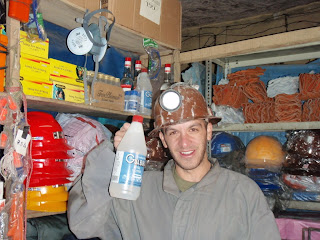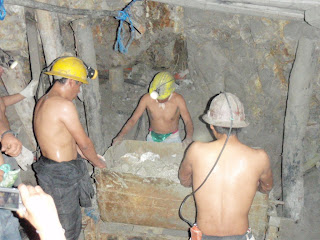Sucre - After making the disastrous decision of consuming a street-sold, spicy chorizo sandwich only minutes before my 8 hour night bus from La Paz to Sucre (a bus which lacked any onboard restroom or even restroom stops for that matter), the majority of my overnight journey was spent wide awake, avoiding any sort of movement that could spur on another type of ¨movement¨ (as well as straying from any sort of sleep which almost always inevitably led to ¨bathroom-seeking¨ missions -- Oh that smart smart brain of mine). With two days too many to spend in Sucre, one of the best kept cities in Bolivia, the highlights can be limited to one severely long, run-on sentence: Nice town, great steak dinner ($8), amazing market with fresh fruit, salteñas and more chorizos (less spicy/bathroom-inducing), only person in the dorm room so didn't meet anyone, lots of wandering. Next city!
Potosi - After months spent traveling from one altitude-inspired record location to another, I finally arrived at Potosi -- The highest city in the world (Boom!). Sitting at 13,420 feet, Potosi is famous for one highlight that brings in thousands upon thousands of tourists every week:
- Potosi Silver Mines - As the highest mine in the world (shocker alert!), my visit to the Potosi Mines was definitely one of the most eye-opening experiences of my trip. Albeit quite depressing, yet still very interesting, the 3 hour tour through the cramped, >100 degree F temperatures tunnels of the mine unveils the life of a typical miner -- Forced into unthinkable working conditions, living off pennies a day, and almost signing their own death warrant as the average lifespan of a miner is limited to only an additional 10 years after day # 1. It is quite amazing that any human being is willing to submit themselves to such a fate, yet for almost 500 years, millions of miners have come and gone (yes, millions), and almost nothing has changed in regard to conditions, pay or miner welfare. It was probably the most depressing, yet eye-opening experience of my trip. I leave you with some less-depressing sub-highlights:
* Purchasing gifts for the miners at the local ¨miners market¨ -- Gifts range anywhere from refreshing drinks and coca leaves (used as a substitute for both food and drink), as well as sticks of dynamite and a bottle of 96% alcohol (yes, the alcohol and dynamite are sold on the same shelf). I can officially confirm the 96% alcohol is not tasty, and burns for about 3-4 hours.
* The local man at our ¨changing room¨ (as to put on protective gear and clothes) who drunkenly offered us a loaded rifle with which to pose during pictures. As a note, his level of 8AM drunkenness equally matched that of our driver who seemed more than willing to nod off and almost drive off every one of the many cliffs we corned on our way to the mine.
* Learning of the many rituals and practices that take place in the mine, inclusive of ¨drunk Fridays,¨ ¨Llama-sacrificing 1st of the month (aka ¨drunk 1st of the months)¨ and ¨no women allowed.¨ It´s a like a strange combination of elementary school and college, yet with more alcohol and dead animals.
* Assisting the miners in about 90 seconds of labor (photo unfortunately lost due to the ¨memory card disaster of 2011¨), providing the instant realization that these men have quite possibly one of the worst jobs in the world (for insight into my ¨Best Jobs in the World¨ list --> #1 = Valet Parker, #283 = Freelance Healthcare Consultant, #861 = Stucchi´s Ice Cream Server).
* Witnessing the most profound ¨miner output¨ -- Kids. There is no more depressing realization how early many of the miners lives are taken than by wandering town and noticing that almost 75% of those on the streets are children. With the average miner supposedly producing up to 8 children, most of whom will become miners themselves, it is a sad future that this city has been founded upon. (Sorry, that definitely doesn´t fit into the ¨less-depressing¨ category).
Tupiza - My final stop in Bolivia before the infamously-popular tour of the Salar de Uyuni (largest salt flat in the world), Tupiza was as close to the Wild West as you may ever see outside of... the Wild West. Known as a ¨hidden gem¨ in Bolivia, I leave you again with some brief, run-on sentence, highlights from my 28 hours in the city: Arrived at 3AM after an overnight bus to wander aimlessly in the freezing cold knocking on any door imaginable for a place to stay (45 minute adventure), 3 hour horse ride whereby my smaller-sized horse showed off his overly-sized Napoleon complex, Salar de Uyuni booking adventure (more on this next blog).
Onto the pics:
Next Week: Salar de Uyuni - A Photographic Adventure Into The Largest Salt Flat in the World
| Sucre - Apparently all you need as to create the allure of a well-kept city is to paint everything with extremely bright, white paint | |
| Mirador (i.e. viewpoint) of the city | |
| The Eiffel Tower of Bolivia - Mysteriously disguised as a playground for children | |
| The Fruit Market - $0.50 for a towering cup (as well as a ¨leftover¨ extra refill) of fresh fruit juice. Delicious. | |
| Potosi - The highest city in the world (with the surprisingly highest mine in the world towering above in the background) | |
| All geared up ready for my tour of the Potosi Mines... not sure what the purpose of the loaded rifle is, but it definitely adds to the moment | |
| Tasting the most popular drink of the miners - 96% Alcohol. Just like a fine scotch, minus the intense burning for hours upon hours afterwards | |
| Dynamite - Unfortunately we weren´t allowed to aimlessly blow anything up in the mines as it apparently is ¨dangerous.¨ Damn you responsible tourism. | |
| The blood-stained entrance into the mine the day after ¨Llama-sacrificing 1st of the month¨ | |
| Paying our respects to the Devil/El Tio/Uncle of the Mine | |
| Miner´s hard at work | |
| They could definitely invest in some larger hallways inside this mine | |
| Horseback riding in Tupiza - The Wild West of Bolivia | |
| Our guide stood about 1/2 mile away to take this photo as to avoid any semblance of facial recognition | |
| A classic end-of-post photo |















No comments:
Post a Comment